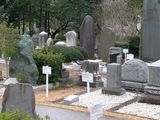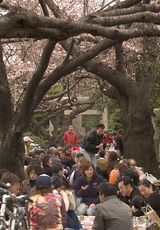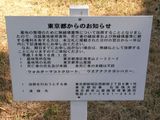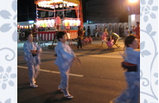August 29, 2005
Aoyama Cemetery--Foreigner’s Graves in Danger
-Guest written by Andrew Edsall, member of the Foreign Section Trust

Do you know that there are nearly 200 foreigners buried in the Aoyama Cemetery in Tokyo—and that these graves are in danger of being disinterred and possibly reburied cheaply elsewhere or placed in a group grave?
Aoyama Cemetery, perhaps best described as an urban oasis, has been in existence for over 130 years. As one of the four city-owned cemeteries, it is the eternal resting place of over 120,000 graves, including many politicians, writers, Hachiko the famous loyal dog, and nearly 200 foreigners since the Meiji period. Today people use the cemetery not only to honor the dead, but to jog, walk their dog, and enjoy cherry-blossom parties in early April.

The foreigners, often known as oyatoi gaikokujin, were a diverse group of teachers, doctors, artists, diplomats, missionaries and ministers, engineers, lawyers, etc. They came here with their families, worked hard, and created schools, hospitals, churches, and other public works and organizations. Not only are the foreigners buried at Aoyama Cemetery historically important as a group, but several of them are famous individuals. Such as Gottfried Wagner, a German chemist, who greatly influenced the ceramic arts by guiding ceramic artists design new glazes and firing techniques or Edoardo Chiosonne, an Italian artist, who designed currency and stamps and other objects, and also amassed a huge collection of Japanese art which is now in Genoa, Italy. Without the hard work and sacrifice of these oyatoi gaikokujin, there is no guarantee that Japan’s future, and other people affected by Japan, would have evolved as it has.
For over forty years, the Tokyo government has been looking to create more park space in the city of Tokyo, even though the cemetery is already used a park. Their original plan called for turning all of the city cemeteries into parks. However, citing public opposition, in 2002 a committee of politicians, academics, and other luminaries decided to only develop about 40% percent of the cemetery. By creating “parklets” (small parks) surrounded by gravestones, the city hopes to increase the amount of park space inside the city limits and increase Tokyo’s status.
In an effort to create the park, the city has published a list in the government publication, the Kampo, of those delinquent in paying the maintenance fee for a grave. In the case of most Japanese, the graves are disposed of after five years, by either reburial in a cheaper cemetery or placement in a group grave. For many years, the graves of the foreigners who contributed to Japan’s developments were exempt from this law. However, in order to free up space for the park, even the foreigners’ graves are now at risk.

In October of last year, white signs in Japanese were placed in front of over half the graves in the foreign section because the city had lost contact with those exempt from paying. The notices say that the family or those with an acceptable relationship to the deceased have one year to contact the appropriate city office – failure to pay will result in the loss of rights to the grave and the graves will then face the risk of being moved or combined. The deadline of October 1st, 2005 is approaching quickly.
The Foreign Section Trust (FST) was founded early in 2004 by Jonathan Wilder and his associates with the goal of preserving the section containing the foreigner’s graves. This group has applied for NPO status, under the name The Foreign Legacy Society, and originally hoped to pay for the delinquent graves through fundraising. However, current laws do not allow non-family members to pay grave fees and the city has refused to budge on this issue. As a result, the focus has now changed to working with the city and various embassies in order to increase information about the cemetery and those buried there.
In addition to the FST, several influential individuals, institutions and academics have made appeals to save the foreign section of graves. This, and media attention to the situation, has caused the city officials to reevaluate their position. Although the control of these graves will probably revert to the city, recent statements by various officials, including the Gov. Shintaro Ishihara, seem to indicate that they have rethought the situation and are considering leaving it as an historical area, in addition to erecting a monument. According to our last meeting with city officials, there are no immediate plans to move the graves. However, the matter is still not decided, and if the rights to the graves belong to the city, there is no guarantee that eventually they will not change their minds. In the meantime, we (FST) will continue research into the names etched into the stone and the stories that lay in the ground.
With support from around the world, and a group of dedicated individuals, hopefully a small, but historically important, section of the cemetery will be saved. For further information or to volunteer to play a role in dealing with the media, constructing the Japanese website, or other activity – such as research, please email info@foreignlegacy.org or visit the website http://www.foreignlegacy.org/wp/.
Do you know that there are nearly 200 foreigners buried in the Aoyama Cemetery in Tokyo—and that these graves are in danger of being disinterred and possibly reburied cheaply elsewhere or placed in a group grave?
Aoyama Cemetery, perhaps best described as an urban oasis, has been in existence for over 130 years. As one of the four city-owned cemeteries, it is the eternal resting place of over 120,000 graves, including many politicians, writers, Hachiko the famous loyal dog, and nearly 200 foreigners since the Meiji period. Today people use the cemetery not only to honor the dead, but to jog, walk their dog, and enjoy cherry-blossom parties in early April.
The foreigners, often known as oyatoi gaikokujin, were a diverse group of teachers, doctors, artists, diplomats, missionaries and ministers, engineers, lawyers, etc. They came here with their families, worked hard, and created schools, hospitals, churches, and other public works and organizations. Not only are the foreigners buried at Aoyama Cemetery historically important as a group, but several of them are famous individuals. Such as Gottfried Wagner, a German chemist, who greatly influenced the ceramic arts by guiding ceramic artists design new glazes and firing techniques or Edoardo Chiosonne, an Italian artist, who designed currency and stamps and other objects, and also amassed a huge collection of Japanese art which is now in Genoa, Italy. Without the hard work and sacrifice of these oyatoi gaikokujin, there is no guarantee that Japan’s future, and other people affected by Japan, would have evolved as it has.
For over forty years, the Tokyo government has been looking to create more park space in the city of Tokyo, even though the cemetery is already used a park. Their original plan called for turning all of the city cemeteries into parks. However, citing public opposition, in 2002 a committee of politicians, academics, and other luminaries decided to only develop about 40% percent of the cemetery. By creating “parklets” (small parks) surrounded by gravestones, the city hopes to increase the amount of park space inside the city limits and increase Tokyo’s status.
In an effort to create the park, the city has published a list in the government publication, the Kampo, of those delinquent in paying the maintenance fee for a grave. In the case of most Japanese, the graves are disposed of after five years, by either reburial in a cheaper cemetery or placement in a group grave. For many years, the graves of the foreigners who contributed to Japan’s developments were exempt from this law. However, in order to free up space for the park, even the foreigners’ graves are now at risk.

In October of last year, white signs in Japanese were placed in front of over half the graves in the foreign section because the city had lost contact with those exempt from paying. The notices say that the family or those with an acceptable relationship to the deceased have one year to contact the appropriate city office – failure to pay will result in the loss of rights to the grave and the graves will then face the risk of being moved or combined. The deadline of October 1st, 2005 is approaching quickly.
The Foreign Section Trust (FST) was founded early in 2004 by Jonathan Wilder and his associates with the goal of preserving the section containing the foreigner’s graves. This group has applied for NPO status, under the name The Foreign Legacy Society, and originally hoped to pay for the delinquent graves through fundraising. However, current laws do not allow non-family members to pay grave fees and the city has refused to budge on this issue. As a result, the focus has now changed to working with the city and various embassies in order to increase information about the cemetery and those buried there.
In addition to the FST, several influential individuals, institutions and academics have made appeals to save the foreign section of graves. This, and media attention to the situation, has caused the city officials to reevaluate their position. Although the control of these graves will probably revert to the city, recent statements by various officials, including the Gov. Shintaro Ishihara, seem to indicate that they have rethought the situation and are considering leaving it as an historical area, in addition to erecting a monument. According to our last meeting with city officials, there are no immediate plans to move the graves. However, the matter is still not decided, and if the rights to the graves belong to the city, there is no guarantee that eventually they will not change their minds. In the meantime, we (FST) will continue research into the names etched into the stone and the stories that lay in the ground.
With support from around the world, and a group of dedicated individuals, hopefully a small, but historically important, section of the cemetery will be saved. For further information or to volunteer to play a role in dealing with the media, constructing the Japanese website, or other activity – such as research, please email info@foreignlegacy.org or visit the website http://www.foreignlegacy.org/wp/.













